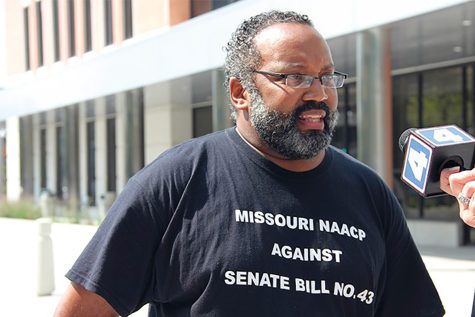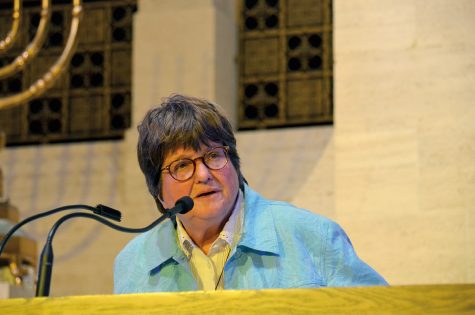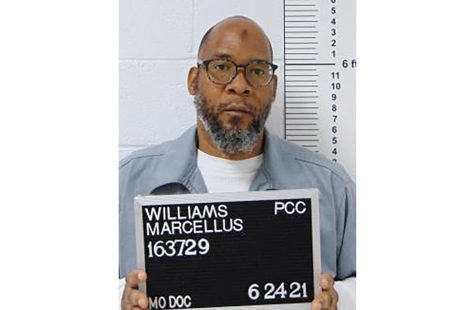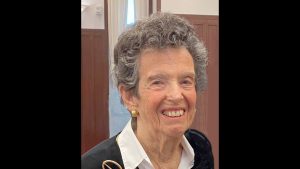Could DNA analysis exonerate death-row inmate Marcellus Williams
DNA analysis reveals that many people in prison are not guilty. Could death-row inmate Marcellus Williams be one of them?
Published November 22, 2022
This story was commissioned by the River City Journalism Fund as part of its series Shadow of Death, which considers St. Louis County’s use of the death penalty.
The Gospel of John tells of Jesus chastising a crowd intent on stoning a woman to death. “He that is without sin among you, let him first cast a stone at her,” the Bible records him saying.
The oft-quoted verse emphasizes a modern-day conundrum: Since everyone has sinned, no one is qualified to throw stones. That maxim could be applied today to a system driven by human flaws that sentences people to death, sometimes even when they’re innocent.
According to the nonprofit Death Penalty Information Center, since 1973 at least 190 people who were sentenced to death in the U.S. have been exonerated.
The center states, “Given the fallibility of human judgment, there has always been the danger that an execution could result in the killing of an innocent person.”
One Missouri case seems to be a textbook example of a perilously imperfect system where a defendant’s race and socioeconomic status, coupled with prosecutors all too eager to get a conviction, led to an unjust death sentence.
Consider the story of death-row inmate Marcellus Williams.
* * *
On a warm, 72-degree night on August 11, 1998, Dr. Daniel Picus arrived at his gated University City home to a horrific scene. He found the lifeless body of his wife, Felicia Gayle. She had been stabbed 43 times with a butcher’s knife.
By all accounts, the victim was a model citizen. Felicia (also known as Lisha) Gayle had been a St. Louis Post-Dispatch reporter. She left the newspaper in 1992 to pursue full-time volunteer work. The newspaper later described Gayle as “a kind and gentle woman who went out of her way to do nice things for people.”
Although Picus put up a $10,000 reward for anyone with information about his wife’s murder, the case went unsolved for almost a year. Then a man named Henry Cole was released from jail in June 1999. He went to University City police and told them that a man he shared a cell with had admitted the crime to him.
That alleged confessor was Marcellus Williams.
Laura Asaro, Williams’ former girlfriend, claimed he had admitted the murder to her, too. Asaro directed police to the Buick LeSabre she said Williams had driven the day of the crime. In the trunk, detectives found Gayle’s ruler and calculator. Police were also able to recover Picus’ laptop from a man who said Williams had sold it to him.
Williams was no stranger to the criminal justice system. He had been previously convicted for burglary. At the time he was charged for Gayle’s murder, the 29-year-old was serving time for armed robbery of a fast-food restaurant.
At Williams’ 2001 trial, prosecutors alleged that Williams was burgling Gayle’s home when she discovered him and, in response, he stabbed her repeatedly.
The jury deliberated less than two hours before finding Williams guilty. They recommended a death sentence. The judge also ordered Williams to serve consecutive terms of life in prison for robbery, 30 years for burglary and 30 years each for two weapons violations.
In time, the date of his execution was set: January 2015.
The Reveal of the Appeals
The appeals process began shortly after Williams’ conviction. His appellate lawyers, Kent Gipson and Laurence Komp, challenged the trial, the conviction and the sentence. They argued that newly uncovered evidence cast further doubt on Williams’ guilt.
The Missouri Supreme Court denied Williams’ appeal in 2003. Two years later, in 2005, the same court denied a second appeal. In 2008, a federal judge in St. Louis denied his claims, too.
Gipson and Komp then asked the U.S. Supreme Court to order the Missouri Supreme Court to hear new evidence in the case. The petition gave several justifications for the request, including the denial of “post-conviction discovery” requests that “sought further DNA testing to help establish his innocence.”
Williams’ lawyers included evidence about Debra McClain — a woman murdered just one month before Gayle in the adjoining suburb of Pagedale in a strikingly similar way. McClain was also stabbed repeatedly, also with a weapon that came from her own kitchen. In both cases, the assailant left the weapon behind.
The lawyers felt that comparing DNA evidence related to the unsolved murder with forensic evidence from Gayle’s killing might prove Williams’ innocence. Their request was summarily denied.
Then, in January 2015, the Missouri Supreme Court delayed Williams’ execution to allow for further DNA testing. In an interview with the St. Louis Post-Dispatch, Gipson expressed his desire that DNA testing and “comparison of any resulting DNA from the Pagedale murder, could reveal evidence that would prove Williams innocent.”
Gipson and Komp also alleged misconduct on the part of prosecutors — and defense lawyers who failed to do their jobs. They noted that Williams’ trial lawyers hadn’t fully vetted the witnesses against him. The pair had admitted they weren’t prepared for the trial. In fact, they wrote, one defense attorney had sought to push Williams’ trial back because he was involved in another capital murder case just one month before.
As for the prosecutors, Gipson and Komp noted that they only turned over arrest and conviction records for Cole and Asaro two days before the trial started. They also failed to disclose information and records — including drug treatment, mental health, and prison and jail records — that could have cast doubt on the witnesses’ testimony.
Debunking Key Witnesses
In their appeal, Gipson and Komp stressed that prosecutors didn’t volunteer all they knew about their witnesses’ histories.
Gipson and Komp described Henry Cole as a “career criminal with convictions dating back 30 years” who would “say anything for money.” They detailed a long history of mental illness that jurors didn’t hear during Williams’ trial. Members of Cole’s family recounted how he suffered from “auditory hallucinations” when he failed to take his psychiatric medications.
Testimonies gathered from Cole’s relatives confirmed his reputation for “providing false information to the police in exchange for leniency.” In one case, the lawyers wrote that Cole “served as an informant against his own son … to get a deal from authorities.”
The lawyers also chipped away at the testimony of the other state witness, Laura Asaro, whom they called a “crack-addicted prostitute.” For example, Asaro told police and prosecutors that she saw a purse containing Gayle’s state identification card in the trunk of Williams’ car. That ID, however, was found in Gayle’s home.
Williams’ lawyers argued that Asaro only agreed to testify against Williams in exchange for the dismissal of outstanding warrants against her and a portion of the reward money. The lawyers found witnesses who testified that Asaro was a “known police informant” with a “pattern of lying to police to get herself out of trouble.”
The witnesses said Asaro admitted to setting up Williams to get the $10,000 reward. Asaro, the lawyers added, “desperately needed this money to feed her crack cocaine addiction, and she had made prior false allegations against others.”
On the issue of the car Asaro told police Williams drove on the day of the murder, multiple witnesses, including Asaro’s own mother, alleged she lied. Each witness testified that Williams’ car was inoperable when Gayle was killed. Gipson and Komp contended that Asaro (who had keys to Williams’ car after his arrest) or the police could have planted Gayle’s possessions in Williams’ automobile.
* * *
The National Registry of Exonerations has comprehensive research on people who’ve been exonerated since 1989. The agency’s stated goal is to “prevent future false convictions by learning from past errors.”
Of special focus: testimony by jailhouse informants claiming someone confessed to them while in custody.
“Jailhouse snitch testimony, as it is commonly known, is notoriously unreliable because the incarcerated witnesses are strongly motivated to say what the prosecution wants, usually because they get substantial reductions in their own sentences in return,” the site notes.
Eight percent of all exonerees in the registry were convicted in part by testimony from jailhouse informants, the agency states. Additionally, it added this:
“Among murders, the more extreme the punishment, the more likely we are to see a jailhouse informant, ranging from 23 percent of exonerations with death sentences to 10 percent of murder cases in which the defendant received a sentence less than life in prison.”
The Advent of DNA Evidence

It was a decade before Gayle’s murder that DNA technology was first introduced as evidence in court cases. With it, forensic genealogists and practitioners were able to help solve criminal cases that had gone cold. They also found hundreds of innocent people who’d been wrongfully convicted.
Tricia Rojo Bushnell, executive director of the Midwest Innocence Project, has spent more than 15 years working on wrongful convictions as both an attorney and law professor. Last year, while serving as an expert witness in a Kansas City death-penalty case, Bushnell addressed how DNA-based evidence has shaken the system. A total of 551 people sent to prison have now been proven innocent thanks to DNA analysis, she wrote.
Even so, she said, in many cases DNA isn’t available — and the legal hoops to get to exoneration entail a costly, complicated process. Since that first DNA-based exoneration in 1989, nine people have been executed for every exoneration.
Experts believe many more innocent people are serving time. Bushnell refers to the number of wrongfully convicted people still in prison as a “dark number” — there’s no way to know just how many people fall in that category. A study published in the National Academy of Sciences that she finds credible suggests it’s likely around 4.1 percent of all death-penalty cases.
Williams’ lawyers have sought to show that he’s in that number.
The appellate lawyers retained experts to examine forensic evidence from the murder victim and her residence. The experts concluded that DNA testing conducted in December 2016 on the murder weapon actually excluded Williams as the contributor of the male DNA found on the knife.
One of those experts, biologist Greg Hampikian, graphically explained how DNA is transferred during a murder like Gayle’s.
“When you’re stabbing, DNA transfers because of restriction and force,” Hampikian told CNN, adding, “If you’re stabbing anyone, you have a good chance of transferring your DNA because of that force.”
The DNA on the knife “isn’t enough to incriminate someone, but it is enough to exclude somebody,” Hampikian said. “It’s like finding a Social Security card with some blurred numbers. There’s still enough there to at least exclude someone.”
Further complicating the prosecution narrative, the bloody footprint found at the murder scene was a different size than Williams’ shoe. Hair fibers found at the scene weren’t Williams’, Gayle’s or her husband’s.
Even so, prosecutors insisted the non-DNA evidence — the laptop and the witness testimonies — was enough to carry out Williams’ death sentence.
In an interview with Al Jazeera, Gipson succinctly summed up the case for his client’s innocence:
“There is no physical evidence, no eyewitnesses that directly connect Williams to the murder, the DNA on the weapon wasn’t his, the bloody footprint at the murder scene wasn’t from Williams’ shoe and was a different size, and the hair fibers found weren’t his.
“It was someone else that killed Gayle, not Williams,” Gipson said.
Race and Unreason
Williams’ lawyers and supporters have highlighted aspects of racial bias in his case. Historically, Black defendants are much more likely to be sentenced to death than white defendants, especially if the victim was white, as Gayle was.
Williams’ jury consisted of 11 whites and just one Black person. This was, of course, no accident. The pool of possible jurors included seven African Americans. Prosecutors struck all but one.
In their appeal, Gipson and Komp noted the bizarre rationale behind the prosecutor’s strike of a potential Black juror named Henry Gooden. Since it’s illegal to remove jurors on the basis of race, prosecutors offered other reasons (see “Black Juror, Bye”). They asserted that Gooden was struck because he wore clothes that resembled Williams’ attire and he worked at the post office. According to the prosecutor’s rationale, postal workers have “liberal, political views” and are inherently anti-death penalty.
In response, Williams’ lawyers insisted Gooden bore no resemblance to Williams, other than his skin color; that other (white) jurors who wore clothing similar to Gooden’s were not struck; that “another postal worker who was Caucasian was not stricken by the State and that Mr. Gooden was unequivocal in stating that he could impose a death sentence.”
The trial court judge ruled that prosecutors had the right to “peremptory strikes based on their hunches” and their reasoning was “race neutral and not of pretextual nature.”
Under the current legal standard in the U.S., prosecutors don’t need to show that an explanation is plausible — only that it might be valid. The appellate court let the strike stand.
* * *
The American Civil Liberties Union, or ACLU, states that the “color of a defendant and victim’s skin plays a crucial and unacceptable role in deciding who receives the death penalty in America.” According to the ACLU, “People of color have accounted for a disproportionate 43 percent of total executions since 1976 and 55 percent of those currently awaiting execution.”
Data from the National Registry of Exonerations also show that innocent Black people are about seven times more likely to be convicted of murder than innocent white people. Additionally, the agency notes, African American prisoners who are convicted of murder are about 50 percent more likely to be innocent than other convicted murderers.
According to the registry, “Many of the convictions of African American murder exonerees were affected by a wide range of types of racial discrimination, from unconscious bias and institutional discrimination to explicit racism.”
At a 2018 press conference in support of Williams, Cassandra Gould, a Jefferson City pastor and executive director of Missouri Faith Voices, expressed the need to examine how race and injustice are intertwined with the death penalty in the U.S.
“There are countless pools of blood that have been crying out from the ground all over America and especially in Missouri, from particularly innocent Black men who are so easily convicted and so easily sentenced to death,” Gould said.
* * *
Despite new evidence, the Missouri Supreme Court ruled that Williams’ execution should proceed. Gipson told the Post-Dispatch that the court’s move was unprecedented.
“We petitioned the court to look at the new evidence … and less than 24 hours later they decided based on the court files that the execution should go ahead anyway.”
Williams was given a new execution date in 2017.
Temporary Reprieve from a Temporary Governor

Marcellus Williams was on the sure track to death before DNA evidence interrupted his destiny. With the news of DNA evidence that seemed to exonerate Williams, the case drew national attention from anti-death penalty groups.
Attorney Barry Scheck, who defended O.J. Simpson as part of his 1994 “Dream Team” and cofounded the Innocence Project, joined Williams’ legal team. The Midwest Innocence Project launched a petition to commute Williams’ sentence, and Sister Helen Prejean, one of the nation’s leading anti-death-penalty advocates, became a vocal ally.
Prejean pleaded with then-Governor Eric Greitens via Twitter. “Here’s what you can do now,” she tweeted on August 16, 2017. “Call Gov. @EricGreitens at (573) 751-3222. Ask him to stop the execution scheduled for August 22.”
* * *
Missouri’s constitution gives the governor power to “grant reprieves, commutations and pardons, after conviction, for all offenses except treason and cases of impeachment.”A 1963 state law grants governors another alternative: the authority to “appoint a board of inquiry whose duty it shall be to gather information, whether or not admissible in a court of law, bearing upon whether or not a person condemned to death should be executed or reprieved or pardoned, or whether the person’s sentence should be commuted.”
With Williams’ execution date looming, the Midwest Innocence Project wrote a nine-page petition to the governor asking him to appoint an independent board of inquiry.
Citing the DNA evidence that seemed to contradict Williams’ guilt, Greitens halted the execution and appointed a board to “consider all evidence presented to the jury, in addition to newly discovered DNA evidence and any other relevant evidence not available to the jury.”
It was a step into almost unchartered territory. Very few boards of this type had been empaneled in the 54 years since state law first allowed them.
Former Governor Mel Carnahan created two in his seven-year term. Attorney Joe Bednar, who served as Carnahan’s chief counsel, later described the boards of inquiry as “a unique process” that deals with “difficult and hard issues” that a governor has to try to balance with justice.
Greitens’ order for Williams came less than five hours before Williams was scheduled to die. Williams’ son, Marcellus Williams Jr., told reporters he and his father had been preparing for execution.
“Me and my father, we said our goodbyes. We said we loved each other, I loved him, he loved me,” Williams Jr. said.
* * *
Members of the board included a host of retired judges: former circuit judges Michael David of St. Louis, Peggy Fenner of Jackson County and Ellen Roper of Boone County; former U.S. District Judge Carol Jackson; and former Missouri Court of Appeals Western District Judge Paul Spinden.
Spinden says, “Our charge was to primarily advise the governor on his response to the petition for clemency. That, of course, entailed looking at the evidence, but the primary focus was on how [Greitens] should respond to the petition.”
But Greitens abruptly resigned less than a year later, before the board could present its official findings. Some advocates questioned whether Greitens might commute Williams’ sentence in his final week in office.
His actions suggest he was willing to allow fact-finding, but in no rush to grant Williams a reprieve. Before leaving office in June 2018, Greitens pardoned people for a range of crimes: victims who killed abusers or rapists and individuals who were given what he felt were unreasonably long sentences.
Williams did not receive a commutation.
When CBS News asked Williams Jr. his thoughts on why Greitens didn’t pardon his father, the son’s response was bitter:
“He’s like, ‘I’m leaving, I don’t care. I do these five pardons, and Marcellus … he can rot.’”
Justice Delayed

It’s been five years since Greitens postponed the execution of Marcellus Williams, and yet his life still hangs in limbo. The board of inquiry submitted its findings to current Missouri Governor Mike Parson in July 2021, but he has taken no action.
Given the gravity of the case, Spinden says he’s not shocked that it’s taken Parson so long to act.
“I can’t say I’m entirely surprised. There’s not a great deal of precedent or experience with this process,” he says. “There was a complex set of facts that took us several years to wade through. So, it doesn’t surprise me that his decision has been delayed.”
Due to state law requiring information gathered by the board be held “by it and the governor in strict confidence,” Spinden declined to comment on the board’s findings.
Parson’s office did not respond to questions about the inquiry’s status.
Michelle Smith, director of community outreach and advocacy for Missourians for Alternatives to the Death Penalty, suspects Parson’s nonaction is politically calculated.
“That honestly is a political stand,” Smith told St. Louis Public Radio in August, adding, “Because you honestly want to come off as someone who is tough on crime, and who is going to make sure that people convicted get their punishment.”
Although “politics” is the job of politicians, Smith said that “justice” should be another political requirement:
“When an error or a mistake comes to light, it is also part of their job within justice to make sure that there aren’t innocent people sitting in prison.”
* * *
Smith’s comment speaks to the complications of a system that is perfectly capable of sentencing innocent people to death.
Eighteen people are currently living under death sentences in Missouri, six of them from St. Louis County. Since 1989, four persons have been exonerated from Missouri’s death row; in that same time, 92 have been executed. Of those, 35 people — or 37 percent — were Black, even though African Americans only comprise 11 percent of the state’s population.
One well-known Missouri case is that of Larry Griffin, a Black man found guilty of a 1980 drive-by murder in St. Louis. The state’s key witness would later admit he wasn’t sure if Griffin was even in the car for the shooting. Griffin was executed in 1995, prompting the NAACP Legal Defense and Educational Fund to declare, “Missouri executed an innocent man.”
Harkening back to the question of who is qualified to cast stones, it is reasonable to address the possibility of wrongful executions in Missouri and throughout the nation. Prejean spoke to this topic in her book.
“If we believe that murder is wrong and not admissible in our society, then it has to be wrong for everyone, not just individuals but governments as well,” Prejean wrote.
Prejean challenged people to question whether an imperfect justice system should have the power to take individuals’ lives — “whether we can continue to allow the government, subject as it is to every imaginable form of inefficiency and corruption, to have such power to kill.”
In this nation, we tolerate with pretense. We pretend there is no unconscious or intentional bias in death-penalty cases, and ignore that prosecutors and judges are capable of letting those biases overrule justice. We invent justifications for a system where witness testimony can be conveniently arranged to achieve a predestined conclusion.
Marcellus Williams remains in limbo, his death sentence on the books, the government holding his life in its hands. This takes us back to where we began this story and emphasizes a still unanswered question:
Who amongst us is qualified to cast the first stone?
For more on the River City Journalism Fund, which provided funding for this project and seeks to support local journalism in St. Louis. The photo of Sister Helen Prejean was courtesy of FLICKR/STEVE RHODES














